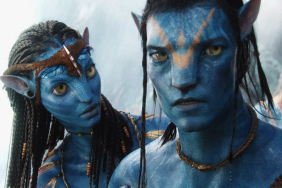
I didn’t necessarily dislike Dawn of the Planet of the Apes, but I became increasingly aware and annoyed by just how predictable and redundant it was. It got to the point a member of my screening audience sitting behind me said, “I knew it was going to be him,” and I wanted to turn around and say, “Yeah, we all knew it was going to be him… about an hour ago.” Outside of a couple of instances, there isn’t a moment in this film you won’t see coming and what’s most disappointing about that is how well made it is, how great the performances are and how utterly great some of the scenes are.
Picking up ten years after the events that followed 2011’s Rise of the Planet of the Apes, a disease ironically dubbed the “Simian Flu” has wiped out the majority of the human population save for a few survivors immune to its deadly effects. Apes, however, had an opposite reaction to the lab-developed virus, which has given them the power of speech and greatly increased their cognitive functions.
Continuing the story of Caesar (performed using motion capture by the excellent Andy Serkis), Dawn largely takes place in the Redwood Forest on the outskirts of San Francisco where over the last ten years Caesar and his “shrewdness” have made their home.
Sign language is their chief form of communication, though their ability to speak becomes a major aspect of the story. Additionally, recognizable scenes from the original Apes franchise find their way into the narrative such as Maurice the Orangutan (Karin Konoval) teaching young apes the alphabet along with the motto “Ape not kill ape,” which will soon be put to the test.
The opening of the film is very well conceived, introducing us to Caesar, his son (Nick Thurston) and the rest of the apes as they set out to hunt in the forest, but soon the humans force themselves into the story via obvious foreshadowing, a narrative thorn that becomes constant throughout the entire movie.
Just as Caesar is sitting down and chatting with Maurice about whether or not the humans have managed to survive, Maurice says they haven’t been seen for two years. Wouldn’t you know, that’s the exact moment the humans come sauntering into the forest.
This is how a bulk of the film is treated, leaving little to no mystery from one scene to the next. The storytelling has all the subtlety of a wreaking ball and no matter how well-acted or how great the scenes are on their own, so much is lost when very little happens you aren’t expecting.
When it comes to the humans, they have ventured from their stronghold in San Francisco to the forest in hopes of getting a dam up and running as they need energy from the running water to keep things operational. Of course, this means you shouldn’t overlook the not-so-subtle commentary that humans can’t seem to recognize how the apes have thrived without such luxuries and yet humans believe the only chance for survival is electricity and all the comforts of a life once lived.
The worst of these humans is Carver (played by Kirk Acevedo), the stereotypical “bad guy” who blames the apes for everything and will have you begging for his death almost as soon as you meet him, and not because he’s so ignorant, but because his character is worthless! He brings nothing to the movie. He only drags it down as we wait for the inevitable. This guy has the nerve to swing on Caesar’s infant son in front of Caesar, his mother and a whole pack of apes. I mean, just kill him, stop wasting my time.
Humans are essentially led by two characters, Jason Clarke as the understanding Malcolm seeking to earn Caesar’s trust and Gary Oldman as the figurehead back at the stronghold. Neither have much of a character arc, though Oldman’s character could have been far more well-developed had he not remained the ape-fearing man he is throughout.
On the apes side of things, Koba (played extraordinarily by Toby Kebbell) is the chief ape antagonist, untrusting of the humans and concerned over what he perceives to be Caesar’s blind trust given Caesar’s upbringing. It’s an understandable plot point, but it’s taken to such cliched extents any hope for originality is lost.
Where the film finds greatness is in the performances from pretty much all involved. The performance capture work combined with the effects is remarkable and just another step up from Rise of the Apes. To know each and every ape is a digital creation is astonishing and to think how well each of the actors embrace their simian characters is impressive and astonishing. You don’t for a minute laugh or believe the situation to be inconceivable as the marriage of visual effects and performance is entirely convincing.
A scene from the film that was already teased online is just as great on the big screen and, in fact, most of Koba’s scenes are great and one of them downright monstrous, but that monstrous scene is also a tonal quandary. The whole idea of “kill or don’t kill?” becomes entirely arbitrary and any realism achieved becomes counter-balanced by cliches that have sullied movies for decades.
I did enjoy Michael Giacchino‘s score, which pays a great homage to Jerry Goldsmith‘s work on the original Apes films, and cinematographer Michael Seresin (Harry Potter and the Prisoner of Azkaban) must have had a hell of a time setting up his shots given the number of scenes set in the rain and mud, not to forget one fantastic tracking shot as Koba commandeers a tank once the shit really hits the fan.
When viewed in pieces, Dawn of the Planet of the Apes is very well made, but as a whole it’s a bit of a non-starter and I can hardly see the point. It feels small, inconclusive and the title doesn’t make much sense. Insurgency of the Planet of the Apes might have been better or Almost the Planet of the Apes as the whole film feels like a footnote to a larger, more compelling story. Of course, the intent is to leave room for Planet of the Apes 3, but if you’re going to skip over ten years of story prior to Dawn of the Apes to only tell me a story that takes place over a couple of days, it better be more than just a set up for another movie two years down the line.









